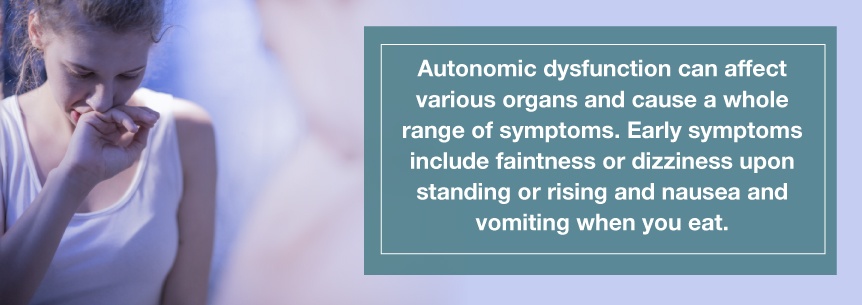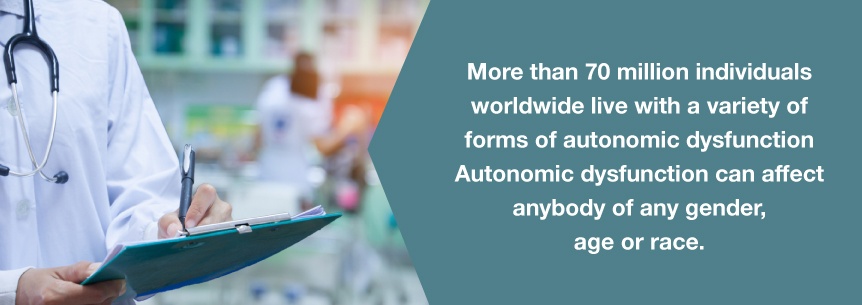Autonomic dysfunction, also referred to as autonomic neuropathy and dysautonomia, isn’t just a straightforward condition. It can be a complication of many conditions, resulting in diverse symptoms including nausea, vomiting, digestive system problems, depression, and anxiety.
Treatment depends on how autonomic neuropathy affects you and the symptoms you’re experiencing. But medical marijuana for autonomic dysfunction can, by itself, treat an array of symptoms from many different conditions. This is good news for those with autonomic neuropathy.
Research on cannabinoid (CB) has grown tremendously over the past 10 years and has shown researchers different functions of the CB system in pathological and normal conditions.
Studies show medical cannabis for autonomic dysfunction is beneficial and can prevent and treat the condition. Medical marijuana has neuroprotective and antioxidant properties which indicate it supports nervous system health and could limit nerve damage or prevent it altogether.
The cannabinoids in cannabis, including THC, have shown efficacy at encouraging neuroregeneration and limiting neuron damage. Cannabinoids also play a role in immune system regulation. These effects regulate inflammatory reactions through components of the adaptive and innate immune responses.
Find A Doctor Find A Dispensary
Please take note that medical pot does have some of its own side effects, including:
You can find a full list of the herb’s side effects here on MarijuanaDoctors.com.
Some symptoms that marijuana for autonomic dysfunction can help with include:
To combat your symptoms, you can try these medical marijuana and autonomic dysfunction strains:
There are various ways to consume medical weed. Each method has its benefits and drawbacks. For example, smoking marijuana can have adverse respiratory effects similar to when you smoke tobacco.
It can take a little experimenting to find the perfect delivery method and tackle your symptoms. But once you find a suitable method that works for you, you’ll start to see the benefits of the treatment.
Individuals have found these delivery methods successful. One of them might be a great method for you to start and experiment with:
A marijuana doctor can provide you with their recommendations of the strains and delivery methods they think will benefit you the most, but typically it takes some trial and error at first.
Now that you’ve learned some information on medical cannabis for autonomic dysfunction, you have the foundation you need to get started with the steps to medical cannabis treatment. Here at MarijuanaDoctors.com, we want to ensure you have all the information you need to make the right medical pot decision for you, right under your fingertips.
Begin by booking an appointment with a qualified cannabis doctor. During your consultation, they may provide you with your recommendation to move forward with treatment. After that, all you have to do is browse our extensive list of marijuana dispensaries so you can begin shopping for cannabis products in your area.
Find A Doctor Find A Dispensary
Autonomic dysfunction describes many conditions and diseases that cause the autonomic nervous system (ANS) to stop working properly. While it’s a complication of many conditions and diseases, it can also be a side effect from certain medicines. One of the keys to treatment is managing the underlying causes.
Your ANS controls various basic functions, including your:
You don’t need to think about these systems for them to function consciously. The ANS is the connection between certain body parts like your internal organs and your brain. For example, the ANS connects your:
Dysautonomia can range from being mild to threatening your life. It can impact part, or all, of your autonomic nervous system. In some cases, the conditions causing problems are only temporary and reversible. Others, however, are long-term, chronic, and continue to worsen over time.
Two examples of chronic conditions that may cause autonomic dysfunction are Parkinson’s disease and diabetes.
Autonomic dysfunction can affect various organs and cause a whole range of symptoms. Early symptoms include faintness or dizziness upon standing or rising and nausea and vomiting when you eat.

You might also struggle with the functionality of the following organs and body parts:
Bladder symptoms may include urinary incontinence and urinary tract infections or not being able to empty your bladder.
Autonomic dysfunction symptoms that affect your digestive system may include:
Autonomic dysfunction symptoms affecting your reproductive organs could include:
Autonomic dysfunction symptoms that affect your blood vessels and your heart could include:
Autonomic dysfunction symptoms that could affect your eyes may include difficulty driving at night and slow pupil adjustment from dark to light.
Autonomic dysfunction symptoms that could affect your sweat glands may include:
Other autonomic dysfunction symptoms may consist of low blood glucose with no warning signals (e.g. shakiness) and weight loss.
Some factors that could cause autonomic nerve injury include:
Some types of autonomic dysfunction can be extremely severe and sudden, but they’re also reversible. Some types of ADS include:
NCS, also referred to as vasovagal syncope, often causes fainting or syncope. The fainting occurs because the sudden blood flow slows to the brain. It can be triggered by:
Patients often have sweating, nausea, ill feelings before and after an event, and excessive tiredness
POTS affects around one to three million people in the U.S., according to dysautonomia Association. Almost five times as many females have POTS compared to men. It may affect adults, children, and teenagers. It may also link with other conditions like Ehlers-Danlos syndrome — an inherited abnormal connective tissue condition.

HSAN is a cluster of related genetic conditions that lead to widespread nerve dysfunction in adults and children. It can cause an inability to feel:
It may also impact a large variety of body functions. The condition is classified by four distinct groups that depend on inherited patterns, age, and symptoms.
MSA is a type of autonomic dysfunction that can be fatal. In the beginning, its symptoms are similar to those of Parkinson’s disease. But individuals with MSA typically have a five-to-10-year life expectancy after their diagnosis. The condition is rare and generally affects adults older than 40. There’s no known cause of MSA, and no treatment or cure slows the disease.
HAS mainly impacts the nerves controlling the eye muscles, leading to vision problems. One pupil is often bigger than the other and constricts slowly in the bright light. HAS often involves both eyes. You may also lose deep tendon reflexes, such as those in the Achilles tendon.
HAS might develop because of a viral infection causing damaged neurons and inflammation. The deep tendon reflex loss is permanent. However, HAS isn’t life-threatening. Glasses and eye drops can help fix vision problems.
Individuals with progressive, chronic, generalized dysautonomia affecting their central nervous system can have a poor long-term outcome. Pneumonia, sudden cardiopulmonary arrest, and acute respiratory failure can cause death.
A study published in the Journal of Neurological Sciences evaluated the relationship between anxiety and depression and autonomic nervous system dysfunction in untreated hypertension. In the study, researchers recruited 98 healthy volunteers and 86 newly diagnosed hypertensive patients.
In the hypertension group, researchers observed substantially higher anxiety scores. There wasn’t any statistically substantial difference in the depression level. However, anxiety can play a more significant role in the development of hypertension than depression. Altered heart autonomic control can be one of the pathophysiological associations between psychological factors and hypertension. However, depression can develop with autonomic dysfunction.
To help to cope, patients can attend therapy with a qualified therapist, counselor or psychologist.
According to Dysautonomia International, here are some facts about autonomic dysfunction:

The term “autonomic nervous system” wasn’t known before 1898 — not until it occurred in a paper about the superior cervical ganglion, associated with the flight or fight response. Before the nineteenth century and after the Renaissance, Knowledge surrounding the autonomic nervous system was derived from anatomical animal studies, and then increasingly in human dissections.
More functional and elaborate anatomical studies were underway by the middle of the nineteenth century. The development of microscopes prompted the evaluation of some tissues and organs, including those of the autonomic nervous system.
Autonomic neuropathy treatment includes two parts: treating the underlying condition and managing specific symptoms.
The initial aim of treating autonomic neuropathy is managing the condition or disease that’s damaging your nerves. For instance, if your underlying disease is diabetes, the doctor would have you tightly control your blood sugar to stop the progression of autonomic neuropathy.
Certain treatments may alleviate specific autonomic neuropathy symptoms. Treatment depends on the area of your body the nerve damage effects and can include the following:
These may include:
Side effects of laxatives may include:
Side effects of antidepressants may include:
Treatment for bladder and urinary symptoms include:
The most common side effect of bladder medication usage is dry mouth. Other side effects may include:
You can undergo various remedies to treat sexual dysfunction, including:
Treating heart and blood pressure issues include:
Side effects of blood pressure treatments will depend on the medication prescribed. Side effects of beta blockers may include:
Heavy abnormal sweating is known as known as “hyperhidrosis” and can be treated by:
A few recent developments in autonomic dysfunction studied in clinical trials include: